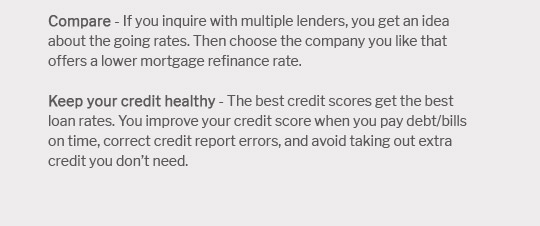 |
|||
 |
 |
 |
||
|---|---|---|
 |
||
 |
||
 |
||
 |
||
 |
 |
 |
 |
Best Refinance Options for Mortgage: A Comprehensive GuideRefinancing your mortgage can be a strategic move to reduce your monthly payments, shorten your loan term, or access your home's equity. Understanding the best refinance options available can help you make an informed decision that aligns with your financial goals. Understanding Different Refinance TypesSeveral refinance options are available, each catering to different needs. It's crucial to understand what each offers. Rate-and-Term RefinanceThis is the most common type of refinancing where you change the interest rate, loan term, or both. It’s ideal for borrowers looking to lower their monthly payments or pay off the loan faster. Cash-Out RefinanceThis option allows you to refinance your mortgage for more than you currently owe, pocketing the difference in cash. It's often used for home improvements or debt consolidation.
Choosing the Right Loan TermThe loan term significantly impacts your monthly payment and the total interest paid over the life of the loan. 15-Year vs. 30-Year MortgageA 15-year mortgage typically offers lower interest rates but higher monthly payments. On the other hand, a 30-year mortgage provides lower monthly payments with a higher interest rate. For those interested in a middle ground, a 25 year mortgage loan might offer a balanced approach. Understanding Current Market TrendsKeeping an eye on the current mortgage rates can help determine the best time to refinance. Analyzing a mortgage interest rates trend graph could provide insights into whether rates are likely to rise or fall. Frequently Asked QuestionsWhat is the best time to refinance a mortgage?The best time to refinance is when interest rates are lower than your current rate, or if you need to access your home equity. It's also wise to refinance if you want to change your loan terms to better fit your financial goals. How much does it cost to refinance?Refinancing costs typically range from 2% to 5% of the loan amount. These costs include appraisal fees, origination fees, and other closing costs. It's important to weigh these costs against the potential savings from a lower interest rate. Can I refinance with bad credit?Refinancing with bad credit is possible but may come with higher interest rates. Consider improving your credit score before refinancing to secure better terms. ConclusionRefinancing your mortgage can be a beneficial financial strategy if approached correctly. By understanding the different types of refinance options and keeping an eye on market trends, you can make an informed decision that best fits your financial needs and goals. https://www.businessinsider.com/personal-finance/mortgages/best-mortgage-refinance-lenders
Rocket Mortgage Refinance by Quicken Loans: Best overall - Third Federal Savings and Loan Mortgage: Best for low costs - Pentagon Federal Credit ... https://mortgageequitypartners.com/top-6-options-for-mortgage-refinance/
A rate-and-term refinance involves replacing your existing mortgage with a new one that has a different interest rate, term, or both. https://www.reddit.com/r/Mortgages/comments/1fo4n2l/whats_the_best_refinance_options/
What's the best refinance options? - apply for a new loan which is 5.4% for 7 ARM and 5.5 for 10 ARM. - modify the current loan with the same ...
|
|---|